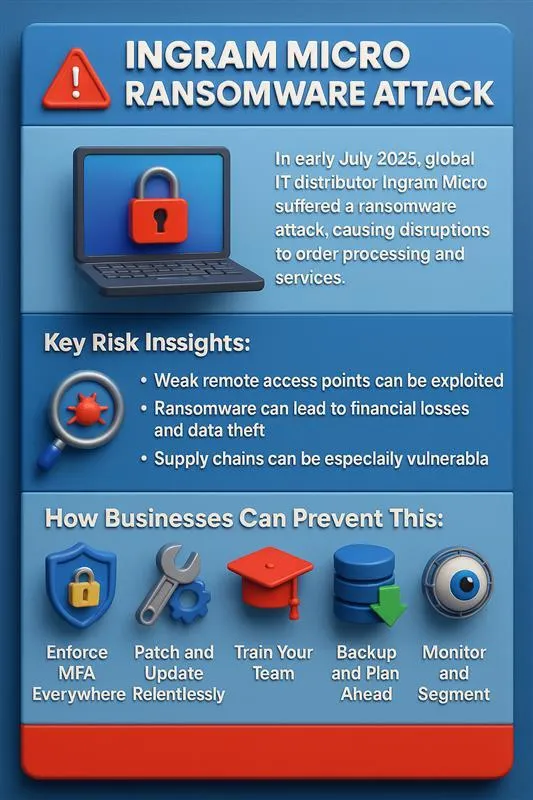
Ingram Micro Ransomware Attack 2025: SafePay Breach Disrupts Global Tech Supply Chain
Just days before the Fourth of July weekend, Ingram Micro—a backbone of the tech supply chain—fell victim to a targeted ransomware attack by the SafePay group. Systems went dark, orders halted, and panic spread. Here’s what we know and how to shield your business from similar attacks.
📅 Timeline of the Ingram Micro Breach
On July 3, 2025, Ingram Micro, one of the world’s largest distributors of IT products and services, discovered a massive ransomware breach within its digital infrastructure. The attack, confirmed to originate from the notorious SafePay cybercriminal group, resulted in:
System-wide shutdowns
Website and e-commerce outages
Paused order processing across global regions
Inaccessible internal platforms
By July 4th weekend, operations across North America, Europe, and Asia were severely impacted. Customers and partners relying on Ingram’s tech distribution faced order delays and communication blackouts.
🕵️♂️ Who is SafePay?
Illustration: A conceptual image of hacker groups using ransomware-as-a-service (RaaS) models.
SafePay has emerged in 2025 as a high-level ransomware-as-a-service (RaaS) group. They’re known for:
Attacking large corporations with vast digital infrastructure
Encrypting systems and demanding cryptocurrency ransoms
Using stealthy phishing and social engineering tactics for initial access
Targeting supply chain providers to cause maximum downstream damage
🌐 The Ripple Effect on the Tech Supply Chain
Because Ingram Micro acts as a digital middleman between manufacturers and resellers, any disruption in their operations hits a massive portion of the global IT ecosystem.
💥 Impacts Include:
Resellers unable to process orders for laptops, servers, and networking gear
Slowed procurement for cloud and SaaS providers
Halted deliveries to SMBs and enterprises relying on Ingram’s logistics
Increased pressure on alternate distributors like Tech Data and Synnex
📊 Embedded Infographic: The Ingram Micro Ransomware Attack at a Glance
Visual breakdown of the attack, impact zones, and cybersecurity prevention tips. Share on LinkedIn or internal teams.
🚨 Why This Attack Matters in 2025
We’re halfway through 2025, and ransomware isn’t just sticking around—it’s evolving. Here's why this attack is a huge wake-up call:
Ransomware groups are refining their strategies—targeting companies with complex infrastructures that rely on uninterrupted digital workflows.
Supply chain attacks have cascading effects that make recovery much more expensive and time-consuming.
Reputation and trust are on the line. Customers don’t forget downtime, especially when it disrupts their own operations.
🛡️ How Can Businesses Protect Themselves?
No one’s untouchable. But you can reduce the risk dramatically by following core cybersecurity strategies.
✅ 1. Enforce Multi-Factor Authentication (MFA)
Why? Even if a password is stolen, MFA adds a second lock.
Best practice: Make it mandatory across all cloud services, internal systems, and VPNs.
✅ 2. Regular Patch Management
Why? Hackers exploit outdated software with known bugs.
Best practice: Automate patching cycles and maintain a vulnerability management system.
✅ 3. Implement Offline Backup Protocols
Why? Ransomware often encrypts online backups too.
Best practice: Keep offline or air-gapped backups and regularly test recovery scenarios.
✅ 4. Employee Cybersecurity Training
Why? Over 80% of breaches start with human error (phishing, weak passwords, etc.).
Best practice: Train staff monthly on identifying phishing emails, malicious links, and odd behavior.
✅ 5. Adopt Zero-Trust Security Models
Why? Don’t assume anything is secure—verify all access.
Best practice: Segment networks, enforce least privilege access, and monitor continuously.
💬 Expert Quote
“This isn’t just a wake-up call for Ingram Micro. It’s a fire alarm for the entire tech industry,”
— Melissa Carter, Cybersecurity Analyst at SecurityBrief Global
🔗 Additional Resources:
🤔 What Should Your Team Do Today?
Ask yourself:
Are our backups offline and tested?
Do we enforce MFA for every user and vendor?
Have employees been trained on phishing this month?
Are we ready to respond if an attack happens this week?
Take one step today. Even a small move—like updating your incident response plan—can save your business from a major crisis.
🔄 Before You Go…
Let’s not wait until the next breach to take action. The Ingram Micro attack is proof that even the giants can fall. But with the right practices in place, your business can avoid being next.
🙋 FAQs
Q: Was customer data stolen in the Ingram Micro breach?
As of now, there’s no confirmation of exfiltrated customer data. Investigations are still ongoing.
Q: Did Ingram Micro pay the ransom?
There’s no public disclosure yet regarding whether a ransom was paid. Like most corporations, they are working with law enforcement and forensic teams.
Q: Is ransomware preventable?
While 100% prevention isn't guaranteed, multi-layered defense significantly lowers your risk and improves your chances of recovery.
🧠 TL;DR Recap:
Ingram Micro was hit by ransomware on July 3, 2025, disrupting systems globally.
The SafePay hacker group is responsible.
The attack impacted the entire tech supply chain.
Businesses must adopt a zero-trust mindset, enforce MFA, patch systems, and train employees.
📣 What’s one cybersecurity step you’ll take today?
Let us know in the comments below or tag a team that needs to see this. Share the infographic, spread awareness, and let’s build a cyber-resilient future—together. 💪
